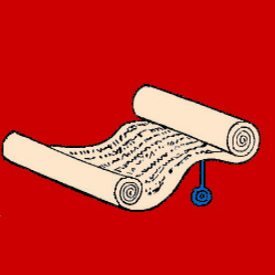
You see a scroll on which you read this prediction of the end of the world:
Quandiu stabit Colyseus stabit et Roma; quando cadet Colyseus cadet et Roma; quando cadet Roma cadet et mundus.
"As long as the Colyseus shall stand, Rome too shall stand; when the Colyseus falls, Rome too shall fall; when Rome falls, the world shall fall as well." (Du Cange in his Glossarium Mediae et Infimae Latinitatis, vol.ii p. 407, Basel edition)
Click here for discussion of this quotation from the Venerable Bede.
The Colosseum may well have seemed as indestructible as the Roman Empire to all who beheld and experienced both, particularly the Romans themselves. However solidly well-built it was--and Vespasian's engineers and builders made it to stand forever--the forces of nature and man seemed to conspire against it.
Aware no doubt of the importance of munera to the stability of their rule and of the popular obsession with the Colosseum and its shows, succeeding emperors attended to improvements of and additions to the structure. There is evidence of modifications by Nerva and Trajan and of a restoration by Antoninus Pius. In 217 CE a lightning strike caused so much damage that gladiatorial combats were suspended until 222-223 CE, when Elagabalus began repairs, which were continued by Alexander Severus, down into the reign of Gordianus III. In 250 CE Decius restored it once again, after it was damaged by a fire caused by lightning. Earthquakes in 442, 470, and 508 CE caused damages that required officials to make repairs repeatedly. The final restoration of the Colosseum was completed in 523 CE by Eutharich, Theodoric's son-in-law, in preparation for the last recorded venationes in the arena (the last gladiatorial combats had taken place in 404 CE).
In 847 CE another earthquake hit the Colosseum, and this seems to have been the beginning of its real destruction. It was used as a shelter for many, who took up residence there, and became a common quarry for those seeking building materials. By the 14th century, the exterior had diminished to what can be seen today, if one can judge from sketches made during that period, while covert plunder of the interior continued until the 19th century, when excavation and restoration of the building began.
Sources: Samuel Ball Platner, Thomas Ashby. A Topographical Dictionary of Ancient Rome; Lawrence Richardson. A New Topographical Dictionary of Ancient Rome.